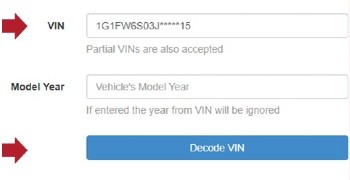The Vehicle Identification Number (VIN) is a unique 17-character code assigned to every motor vehicle. This number, mandated by the National Highway Traffic Safety Administration (NHTSA), acts as a vehicle’s fingerprint, encoding crucial details about its origin and specifications. For automotive professionals and vehicle owners alike, understanding how to perform a Vin Features Lookup is invaluable.
NHTSA, as the federal agency dedicated to vehicle safety, provides a public VIN decoder tool on their website. This free resource allows you to decode any VIN and access a wealth of information, including the vehicle’s manufacturing plant. Knowing the assembly plant location can be particularly useful for diagnostics, parts sourcing, and verifying vehicle history.
Here’s how to easily perform a VIN features lookup and pinpoint the manufacturing plant using NHTSA’s official VIN decoder:
Step 1: Access the NHTSA VIN Decoder
Navigate to the official NHTSA VIN Decoder website: https://vpic.nhtsa.dot.gov/decoder/. This is your starting point for any comprehensive vin features lookup.
Step 2: Input the VIN and Decode
Locate the text box on the VIN decoder page. Enter the complete 17-digit VIN of the vehicle you are researching. After entering the VIN, click the “Decode VIN” button to initiate the vin features lookup process.
Step 3: Locate the Manufacturing Plant Details
Once the decoder processes the VIN, it will display a detailed results page. Scroll down to the bottom of the results. Here, you will find a field specifically labeled with the vehicle’s “Build Plant” and “Country of Manufacture.” This section provides the precise location where your vehicle was assembled, a key piece of information revealed through the vin features lookup.
By utilizing NHTSA’s VIN decoder for a vin features lookup, you gain access to verified manufacturer-reported data. This capability not only helps in identifying the manufacturing plant but also unlocks a range of other vehicle specifications, making it an essential tool for anyone working with or researching vehicles. Remember, for any further inquiries about the decoded information, contacting the vehicle manufacturer directly is recommended, as they are the primary source of this data.
